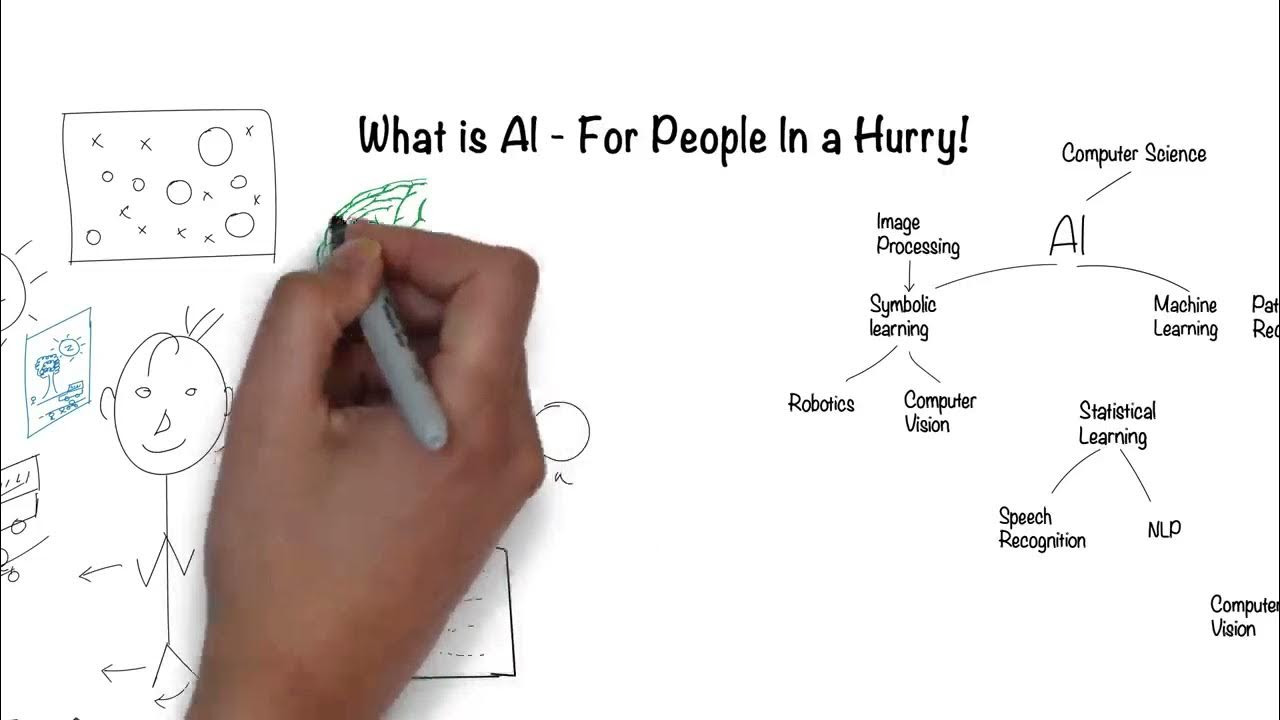ML model categories
Summary
TLDRThis video script provides a comprehensive overview of machine learning (ML), differentiating between artificial intelligence (AI) and its subsets. It explains supervised learning, which uses labeled data for predictions (classification and regression), and unsupervised learning, which identifies patterns in unlabeled data (clustering, association, and dimensionality reduction). Through practical examples, the script illustrates how these concepts apply to real-world problems, engaging viewers with interactive scenarios to test their understanding of ML applications. This foundational knowledge sets the stage for deeper exploration of machine learning techniques.
Takeaways
- 🤖 Artificial intelligence (AI) encompasses various technologies that mimic human intelligence, including robots and self-driving cars.
- 📚 Machine learning (ML) is a subset of AI that enables computers to learn from data without explicit programming.
- 🔍 Supervised learning uses labeled data to train models for specific tasks, like classifying images of dogs and cats.
- 🔎 Unsupervised learning deals with unlabeled data, allowing the machine to find patterns and group data points.
- 🐶 Classification in supervised learning predicts categorical variables, while regression predicts numerical variables.
- 📊 Examples of supervised learning models include logistic regression for classification and linear regression for regression problems.
- 🔗 Unsupervised learning types include clustering, association, and dimensionality reduction.
- 📈 Clustering groups similar data points, while association identifies correlations between items, and dimensionality reduction simplifies datasets.
- ✅ Customer spending prediction based on purchase history is a supervised regression problem.
- 🔍 Identifying customer segmentation without labeled data is an unsupervised clustering problem.
Q & A
What is the primary distinction between artificial intelligence and machine learning?
-Artificial intelligence (AI) is a broad term that encompasses any computer system mimicking human intelligence, while machine learning is a specific subset of AI that enables computers to learn from data without explicit programming.
What are the two main categories of machine learning?
-The two main categories of machine learning are supervised learning and unsupervised learning.
Can you explain what supervised learning entails?
-Supervised learning involves using labeled data to train a machine. In this method, the computer learns from the input-output pairs, allowing it to make predictions on new, unseen data.
What is the difference between classification and regression in supervised learning?
-Classification predicts categorical variables, while regression predicts numeric variables. For example, classification determines whether an image shows a cat or dog, whereas regression forecasts sales figures.
What does unsupervised learning focus on?
-Unsupervised learning focuses on unlabeled data, where the machine identifies patterns and groups data points based on their characteristics without prior knowledge of the labels.
What are the three major types of unsupervised learning?
-The three major types of unsupervised learning are clustering, association, and dimensionality reduction.
What is clustering, and how is it used?
-Clustering groups together data points with similar characteristics. It is commonly used for tasks like customer segmentation based on demographics.
How does association learning work?
-Association learning identifies relationships between data points, such as finding correlations between products to enhance placement in stores for promotions.
What is dimensionality reduction, and why is it important?
-Dimensionality reduction simplifies datasets by reducing the number of features, which can improve the efficiency and performance of machine learning models.
In the example given, why is predicting customer spending considered supervised learning?
-Predicting customer spending is supervised learning because it involves labeled data, where past spending amounts are known and used to predict future spending.
What machine learning model is suitable for a regression problem?
-A linear regression model is suitable for regression problems, as it predicts continuous outcomes based on input features.
Why would customer segmentation be classified as unsupervised learning?
-Customer segmentation is classified as unsupervised learning because there are no predefined labels for each customer segment; the machine identifies underlying patterns based on the data.
Outlines

هذا القسم متوفر فقط للمشتركين. يرجى الترقية للوصول إلى هذه الميزة.
قم بالترقية الآنMindmap

هذا القسم متوفر فقط للمشتركين. يرجى الترقية للوصول إلى هذه الميزة.
قم بالترقية الآنKeywords

هذا القسم متوفر فقط للمشتركين. يرجى الترقية للوصول إلى هذه الميزة.
قم بالترقية الآنHighlights

هذا القسم متوفر فقط للمشتركين. يرجى الترقية للوصول إلى هذه الميزة.
قم بالترقية الآنTranscripts

هذا القسم متوفر فقط للمشتركين. يرجى الترقية للوصول إلى هذه الميزة.
قم بالترقية الآنتصفح المزيد من مقاطع الفيديو ذات الصلة

Artificial Intelligence (AI) for People in a Hurry

Artificial Intelligence Class 10 Ch 1 |AI vs Machine Learning vs Deep Learning (Differences) 2022-23

AI & ML Explained in Malayalam

PERCOBAAN

AI vs ML vs DL vs Data Science - Difference Explained | Simplilearn

AZ-900 Episode 16 | Azure Artificial Intelligence (AI) Services | Machine Learning Studio & Service
5.0 / 5 (0 votes)
